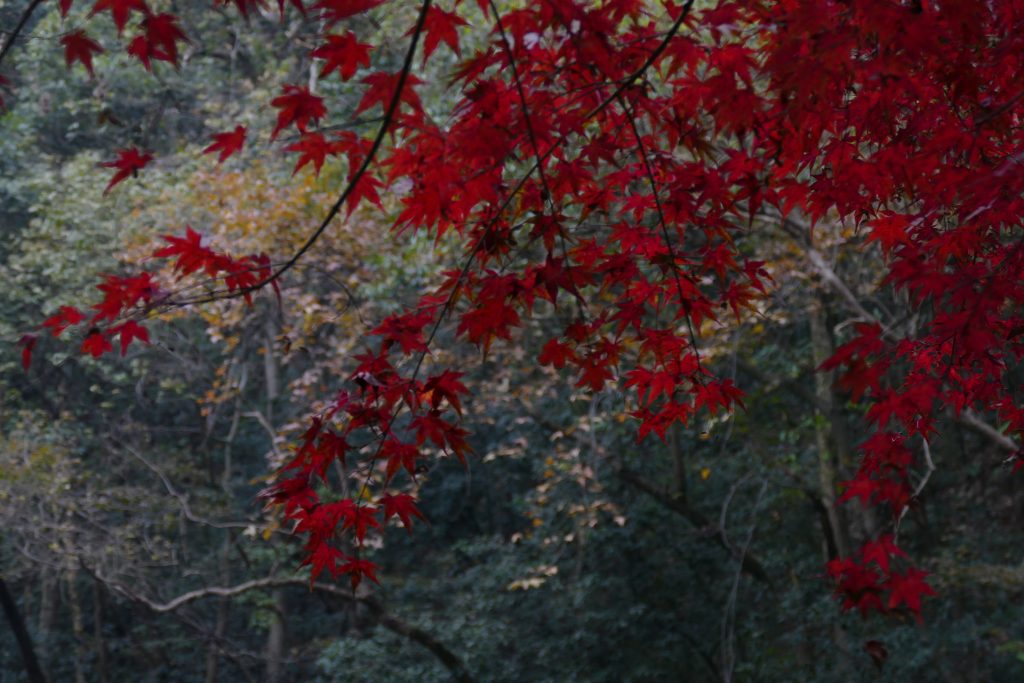

Jashn-e-Mehregan is recognised as a harvest festival and a time for thanksgiving, where friends and family share food, often ending with a bonfire and fireworks. People wear new clothes, and a sofreh, or spread, is laid out with wild marjoram, a mirror, and a sormeh-dan (a decorative pot of kohl), along with a holy book. This sofreh is adorned with rose water, flowers, and such seasonal produce as pomegranates, apples, almonds, and pistachios. At lunchtime, the family stands before the mirror to pray, before kohl is applied around the eyes as a good omen.

Autumn red leaves at Hupaomengquan (Dreaming of the Tiger Spring) – Hangzhou, Zhejiang, China, 21.11.2014
Autumnal Equinox is a celestial event that occurs each year the moment the sun crosses the equator from north to south, and day and night are said to be of equal length. This is officially the beginning of autumn: the transition from summer to winter. The earth begins to cool down, the nights grow longer, and nature appears to prepare for a long and dark period of withdrawal. This equinox has traditionally been associated with harvest festivals, feasts, and the offering of crops to divine entities.
In Britain, Pagans celebrate Mabon on the day of the equinox, and a harvest festival is held on the nearest full moon, also known as a Harvest Moon. It is a time to rejoice and reflect on the past year, to absorb the satisfaction of all that has been accomplished. It is also a time of balance and gratitude, for securing the blessings of the Goddess. An altar is set up with candles and seasonal fruits collected from gardens and orchids; apples are especially revered. The dark is honoured, and rituals of gratitude are held. In rural Britain, it was customary to drink dandelion and burdock cordials at this time of year in order to purify the blood and prepare the body for the seasonal changes ahead.
Similarly, Iranians and Zoroastrians across the world celebrate Jashn-e-Mehregan, or the Persian Autumn Festival. The beginning of October marks winter’s commence and the time for harvest, with a six-day feast being held, of which the first and last days are dedicated to prayer. Mehregan is named after the Zoroastrian Goddess Mehr, who defeated evil and darkness, often depicted by a victorious lion looming over a bull. Mitra, the Angel of Covenant and Oath, is also honoured, as are friendships, affection, and love. It also venerates the festival as the day when King Fereydoun and Kaveh of Ferdowsi’s Shahnameh triumphed over the evil dragon Zahhak, making it a day of victory.
Today, Jashn-e-Mehregan is recognised as a harvest festival and a time for thanksgiving, where friends and family share food, often ending with a bonfire and fireworks. People wear new clothes, and a sofreh, or spread, is laid out with wild marjoram, a mirror, and a sormeh-dan (a decorative pot of kohl), along with a holy book. This sofreh is adorned with rose water, flowers, and such seasonal produce as pomegranates, apples, almonds, and pistachios. At lunchtime, the family stands before the mirror to pray, before kohl is applied around the eyes as a good omen.
Moving further east to the Indian Subcontinent, we have some of the most significant festivals in the Hindu calendar tied to the Autumnal Equinox, namely Durga Puja in its various regional forms, and Dussehra. Durga Puja marks the defeat of Goddess Durga, who is often seen riding a lion, over the buffalo demon Mahishasura, and the ultimate victory of good over evil. It is the biggest festival of the year in West Bengal and neighbouring Nepal and Bhutan, celebrated over a ten-day period with much fervour and dedication. Huge clay sculptures of the Goddess are made and decorated for street processions and worship, before being immersed into water with plenty of fanfare.
In Gujarat, this festival is known as Navratri, or nine nights, and the Goddess is placed at the centre of a hall or large public space atop a platform adorned with oil lamps, flowers, fruits, and sweetmeats. Worshippers dance in a circle around the platform to represent the womb and the Mother Goddess. It also represents the circle of life, from birth to death to rebirth, with the only constant factor in this ecstatic and frenzied circle being the Goddess. Today, the dances, known as Garba and Dandiya Raas, and the energetic Gujarati folk music associated with the festival, can have a playfully competitive streak to them, sometimes resulting in elaborate and acrobatic steps and routines, ultimately resulting in international appreciation and promotion.
According to the ancient Indian system of medicine of Ayurveda, though the autumn season, known as Sharad in Sanskrit, is pleasant, mild, and refreshing, with the heat of summer giving way to a cooler climate, this change in seasons makes one the most susceptible to diseases. As a result, detoxification therapies are prescribed along with bitter, light foods and exercise.
From west to east, seasonal and celestial observances have been celebrated in demonstrably similar ways, and continue to do so irrespective of religion. Astronomical occurrences have a direct effect on the earth and all its inhabitants, marking significant events and changes of seasons. They are times for us all to celebrate and reflect, to appreciate nature and the earth’s bounties. They can ultimately help us see that we are all one sharing this gracious and forgiving planet, and that we have more in common than we have differences.
Story by Cheragh Tankaria

